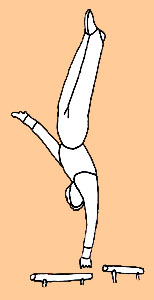 |
Climbing and Gymnastics A Historical Association |
 |
Climbing and Gymnastics A Historical Association |
Among Past Generations . . . Varying Degrees of Gymnastic Expertise Harold Goodro established America's first 5.10 when he climbed Goodro's Wall in Utah in 1949. "He could do some of these arm crankers . . ." (Greg Lowe in Wizards of Rock, 2002). Goodro may have been the Utah State Rope Climbing Champion. Walter Bonatti has written of exercising on the parallel bars to prepare for climbing. 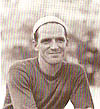 Joe and Paul Stettner were Turnverein members. Here is an excerpt from The Stettner Way, by John D. Gorby (2003): "Paul's son, Paul, Jr. . . .'I remember going with dad to Turnverein, a worker's gymnastics club, every Friday night, where we worked on calisthenics, on apparatus and high and parallel bars and played volley ball . . . My Uncle Joe didn't work out quite as much . . .' " 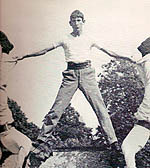 George Leigh Mallory was a gymnast at Winchester School - a tumbler and horizontal bar performer. He was able to do giant swings - considered very advanced at the time - the only boy at school able to do so. L. S. Amery, in Days of Fresh Air (1939), recounts his experiences as a Harrow student in 1891: "In fact, I only definitely excelled in one athletic pursuit - gymnastics. My chief competitor here was Max Mactaggart, a lighter and more finished performer, though not quite so strong. At Aldershot we were supposed to be favourites, but Cranleigh, with the advantage of a marvelous young Siamese gymnast . . . won fairly easily, leaving Harrow third, while I had the slender consolation of having secured the highest individual marks on horizontal bar and on the rope." (The gymnasium at Harrow was built after fund raising produced a sum of 4,000 Pounds in 1873, so gymnastic instruction on the apparatus began at the school after that date). A distimguished politician and war correspondent, Amery was a member of the British Parliament, and was First Lord of the Admiralty (1922-1924). He was proficient in at least seven languages. |
More Recently . . . Climbers who are or were Artistic Gymnasts 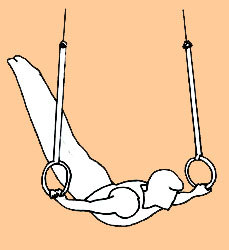
Since the documented beginnings of rock climbing and bouldering in the 1880s, many climbers have engaged in gymnastics at some point - virtually all of them have if we use a broad interpretation of the word gymnastics. The Turnverien movement in Germany was very popular at the beginning of the 20th century, and assuredly any number of German climbers also performed gymnastic exercises. There were (and are) those, however, who achieved some degree of mastery on one or more of the classical pieces of gymnastic apparatus: the horizontal bar, the parallel bars, the rings, the pommel horse, the vaulting horse, free exercise, the rope, the balance beam, and the uneven bars. By this I mean that these performers were able to gracefully execute moves at or near the top of the difficulty scale as it was defined at the time. 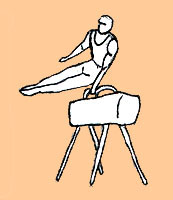 Most
of these climbers benefited from their gymnastics in some way. I found
my expertise on the 20' climbing rope and still rings were a huge asset
to my climbing. Others have described a similar association of
strengths and skills. However,
some climber/gymnasts have found that the carry-over was of a different
nature or was less pronounced in their climbing performances. Most
certainly, apparatus work and rock climbing are distinct activities,
and whereas certain gymnastic moves may carry-over well from
one apparatus to another, the skill proximity
between gymnastics and climbing is a bit more tenuous. It cannot be
said,
in general, that formal gymnastics is advantageous for climbers. For
some, yes, for others, no. Most
of these climbers benefited from their gymnastics in some way. I found
my expertise on the 20' climbing rope and still rings were a huge asset
to my climbing. Others have described a similar association of
strengths and skills. However,
some climber/gymnasts have found that the carry-over was of a different
nature or was less pronounced in their climbing performances. Most
certainly, apparatus work and rock climbing are distinct activities,
and whereas certain gymnastic moves may carry-over well from
one apparatus to another, the skill proximity
between gymnastics and climbing is a bit more tenuous. It cannot be
said,
in general, that formal gymnastics is advantageous for climbers. For
some, yes, for others, no. A number of the current young exemplars of rock have done little or no gymnastics, and lack even an approximation of the muscular development of the modern male gymnast. Indeed, a well-developed musculature may at times work to one's disadvantage on rock where the delicate lightness of a child or small woman would be of greater value. Sometimes genetic qualities - a very fine bone structure and thin profile - eclipse any benefit to heavier climbers provided by gymnastics. It's a weird activity to have become so competitive. As for female climbers in particular, I've seen some who are actually more muscular than world-class women gymnasts. So much for generalities! 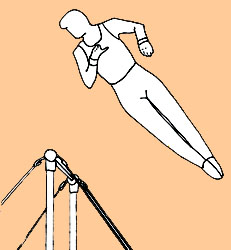
Nevertheless, for some climbers artistic gymnastics training has had a positive effect. Here, then, are a few of the climbers I'm aware of who have credited this form of gymnastics with providing some measure of benefit to their climbing . . . If you would like to suggest others, contact me at john at the domain of this website. I have intentionally excluded those rock climbers who only did isolated gymnastic exercises directly related to climbing and did not strive to meet the recognized standards of the apparatus they employed. |
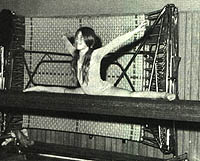 Lynn Hill
became involved in gymnastics as a young girl. She writes: "My coach, Scott Crouse, was a
former competitive gymnast . . . One day he suggested I try a double
back flip . . . I discovered I could dismantle the movement and focus
on each separate phase of it . . . called 'chunking' . . . I had
discovered a powerful learning tool for getting my body to follow
whatever my mind imagined. Visual learning, I would later find, also
had direct applications to rock climbing. . . . as an eager young girl,
I was more interested in learning complex acrobatic maneuvers
than focusing on pretty formalities . . . As gymnastics became more
rigid and structured, I began to lose my motivation and enthusiasm
for remaining on the team."Climbing
Free (2002) (Photo:
Lynn Hill
Collection) Lynn Hill
became involved in gymnastics as a young girl. She writes: "My coach, Scott Crouse, was a
former competitive gymnast . . . One day he suggested I try a double
back flip . . . I discovered I could dismantle the movement and focus
on each separate phase of it . . . called 'chunking' . . . I had
discovered a powerful learning tool for getting my body to follow
whatever my mind imagined. Visual learning, I would later find, also
had direct applications to rock climbing. . . . as an eager young girl,
I was more interested in learning complex acrobatic maneuvers
than focusing on pretty formalities . . . As gymnastics became more
rigid and structured, I began to lose my motivation and enthusiasm
for remaining on the team."Climbing
Free (2002) (Photo:
Lynn Hill
Collection) Lynn is perhaps the world's finest rock climber. She is an outstanding example of a gymnast who has excelled in climbing. |
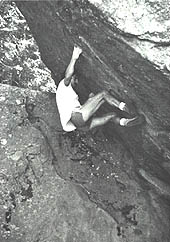 Rob Candelaria was an
accomplished gymnast, and instructs others in a school of gymnastics he
created: the Colorado
Athletic Training
School in Boulder. Rob also coaches young rock
climbers. Rob Candelaria was an
accomplished gymnast, and instructs others in a school of gymnastics he
created: the Colorado
Athletic Training
School in Boulder. Rob also coaches young rock
climbers.Photo by Pat Ament - 1970s "The mid and later 1960s [at Flagstaff Mountain] have been dominated by the pioneering achievements of Rob Candelaria and . . . Jim Holloway. Candelaria's gymnastic prowess was somewhat revealed one day when he did Pratt's Mantel and then pressed into a handstand on it" - Pat Ament in A Climber's Playground . . . (1980) |
 Dick
Williams learned how to use momentum in
gymnastics,
and became one of America's finest early dynamic climbers. He
introduced bouldering to the Gunks, and astounded climbers there with
his radical technique. From Dick . . . Dick
Williams learned how to use momentum in
gymnastics,
and became one of America's finest early dynamic climbers. He
introduced bouldering to the Gunks, and astounded climbers there with
his radical technique. From Dick . . . "I began gymnastics about 1952, floor, high bar, horse and parallel bars. It was a slow process because we pretty much had to learn without any instruction. I excelled in parallel bars and floor exercises and by senior year was involved with quite a bit of competition and simple performance/entertainment shows. When I started climbing in the Gunks in 1958 I was in the Submarine service, so I didn't get much time actually on the rock. When I did, dynamic moves came 100% naturally from almost the very beginning, made moves so much more effective and affected how I approached all climbs. We also rope climbed (we had a gym instructor who came from Europe - we were very lucky, he didn't train us but allowed us to use the equipment that would have otherwise been kept locked up) and got so we'd compete with each other from a 'sitting on the floor' start - it was a lot of fun" (Photo on Devils Tower) |
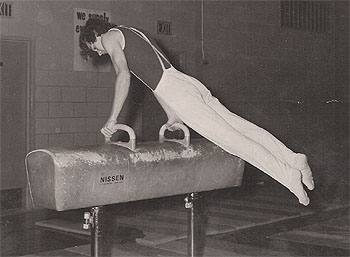 Curt Shannon
is
a climber who has specialized in bouldering over the past few years.
Near
the age of fifty, Curt is one of the leading older veterans of the
sport.
He and I have talked about the role of gymnastic training from time to
time. These days, Curt's specialty is micro-hold problems, distinctly
unrelated to doing a Moore on the horse! But his precise style,
agility, and control may well have their origins in his gymnastics.
From Curt . . . "I was
a High School gymnast myself, going to the Minnesota State gymnastics
meet twice and getting into the pommel horse finals one year--finishing
8th. This was in the early 70s and we only had "A," "B" and "C" moves
then. The initial appeal that rock climbing had for me was its
similarity to gymnastics. And, although I think the strength training
from gymnastics is useful and has some application to climbing, I think
the balance and kinesthetic awareness gained from the sport is even
more important. In fact, as far as strength goes, gymnastics does very
little, if anything, to train finger strength--and that may be
the most important type of strength to have in climbing higher
grades" Curt Shannon
is
a climber who has specialized in bouldering over the past few years.
Near
the age of fifty, Curt is one of the leading older veterans of the
sport.
He and I have talked about the role of gymnastic training from time to
time. These days, Curt's specialty is micro-hold problems, distinctly
unrelated to doing a Moore on the horse! But his precise style,
agility, and control may well have their origins in his gymnastics.
From Curt . . . "I was
a High School gymnast myself, going to the Minnesota State gymnastics
meet twice and getting into the pommel horse finals one year--finishing
8th. This was in the early 70s and we only had "A," "B" and "C" moves
then. The initial appeal that rock climbing had for me was its
similarity to gymnastics. And, although I think the strength training
from gymnastics is useful and has some application to climbing, I think
the balance and kinesthetic awareness gained from the sport is even
more important. In fact, as far as strength goes, gymnastics does very
little, if anything, to train finger strength--and that may be
the most important type of strength to have in climbing higher
grades" |
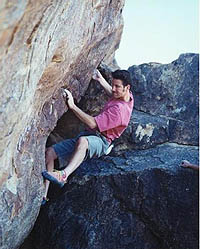 Kerwin Klein - gymnast,
academic, superb boulderer and climber - provides a very interesting
commentary on the relationship between gymnastics and
climbing : Kerwin Klein - gymnast,
academic, superb boulderer and climber - provides a very interesting
commentary on the relationship between gymnastics and
climbing : Photo
by Curt Shannon
"In the early 1980s, as Jean Bonner and I were riding up the fire road to Black Mountain, the fuel line on her ’66 VW van ruptured, splashing high-octane across the overheated engine. The van stalled as the fan belt melted in the flame. I leapt out, opened the side door, and made an emergency decision: I reached into the back for my brand new, laminated, maple gymnastics rings and carried them off to safety. Then, I went back and doused the fire. I wasn’t much of a gymnast, but I had my priorities straight. "At age 19 I had found a home in mountain climbing after years of other sports—motocross, football, a bit of recreational gymnastics. Mountain climbing led me to the local boulders, at Larrabee Beach State Park, and bouldering brought me back to gymnastics. There were no climbing gyms, so during the wet winters of the Pacific Northwest, gymnastics offered a way to stay in shape. Beside, I had read an obscure book, Master of Rock, about a guy named John Gill who had mixed gymnastics with climbing. I specialized in the rings, although I also climbed rope, initially as a complement to climbing. Soon after moving to Southern California in 1981, I bought my rings and began coaching men and women’s gymnastics at the YMCA in San Jacinto. Later, I moved on to the Riverside Y where I coached the Men’s Team for another five years or so. I never really competed, and my ring work could be charitably described as mediocre, but I could do giants and kips, had a creditable front lever and cross pullout, and a half-assed inverted cross. My best trick was my V-sit that I could lower down into a ¾ cross and then pull out. I loved ringwork almost as much as the mountains, but I was especially intrigued by the idea of blending gymnastics and climbing. Although I did a lot of roped climbing, I came to prefer hard bouldering and long, easy solos to messing with gear. In those days there were few bouldering specialists on the West Coast, although many of the top climbers, notably John Long and John Bachar, took bouldering very seriously. I was deeply impressed by Bachar, but Long was more nearly a model, as famous for his beefcake coverspreads for Climbing magazine as for his bouldering. Neither I nor anyone else was going to replicate Largo’s corn-fed physique on a diet of rock climbing. I had a terrific time trying to keep muscle on—rings, weights, and protein shakes would add muscle, then hours of hiking and climbing would burn it off. So I’d train more, get into good shape, and then snap a tendon and go back to hiking for two or three months and come back skinny again. I spent more time rehabbing than climbing for many of those years—and coaching didn’t help, with my inflamed rotator cuffs sometimes the only thing standing between an out-of-control gymnast and a hard landing. Climbers today may find it hard to believe, but I was constantly working to add weight. In the 1980s the bodybuilding aesthetic went mainstream—the waxed pecs of Sylvester Stallone and Arnold Schwarzenegger replaced Sean Connery’s hairy but considerably less robust chest as markers of ideal manhood. And since I had grown up in Southern Illinois, where the ability to eat, drink, and get big enough to toss hogs were standard measures of masculinity, I had special body issues. At one point, I think it was the summer of 1990, when I was at my beefiest, at least as a climber, I went back home to Southern Illinois for a visit. I weighed about 190, without much body fat. My relatives were horrified—they thought I was emaciated, and they fretted over my health. They stuffed me with pie and pork chops, and by the time I hit the road west, I was over two hundred pounds (they still thought I was too skinny). Needless to say, the next week was not one of my more triumphal bouldering tours. But as in Gill’s case, part of my love for training grew out of cultural notions about what constituted the ideal male body as much as interest in improving my climbing. Not surprisingly, I developed a taste for the few routes that rewarded all those hours on the rings, and on Southern California granite, in the 1980s, that meant mantles with an occasional juggy roof or crack thrown in. By 1984 I had built up a circuit of B2 mantles at Black Mountain and Joshua Tree, but the next five years were devoted to work, school and a seemingly endless cycle of injuries. Gymnastics and bouldering didn’t really come together for me until I spent a year in Arizona. Once there, I realized that my bouldering had stagnated badly. In 1989 I landed in Tucson for a year of graduate school and quickly smacked into Bob Murray’s legacy. Murray had left a slew of inconceivably hard routes in the surrounding desert. I spent several months bouldering with some of his old partners, John Gault and George Smith, usually watching as they hung, upside down and barefoot, on underfed holds that looked more suited to slab climbing. They told me terrifying Murray stories: dropping thirty pounds to maximize his crimp strength; slicing a snickers into tiny bites to place on the exit holds of one of his projects as a motivator; his bouldering partner, Frank Abell, damaging his heart with climbing-related dieting. I have no idea how many of the stories were true, but the routes were fascinating—sit-down traverses across low, roofy chunks of rhyolite, in bare feet because the underslung footholds were too small to accept period climbing shoes. John and George also had a visually distinct style that apparently descended from Murray: they never hooked their heels; they avoided matching hands in favor of crosses; and their traverse sequences frequently placed the weak hand on the worst hold of the route. Although I had bouldered eliminates before, and Gill and others had practiced them for decades, I had never seen elimination done so systematically. Each and every rhyolite ripple had been stroked into some sequence—we could spend hours on a crummy little butt nugget less than forty square feet without ever repeating a route. Before the rise of climbing gyms, that sort of focus was unusual. I never truly developed a taste for power crimping, but I did start working a lot more on my finger strength, and after I returned to Southern California, began integrating gymnastics and bouldering more seriously. I kept up some of my rings skills and thought more analytically about ways to translate those motions to the rock. I could think of at least three models for mixing gymnastics and boulders. The most developed was that of Gill himself, which I knew largely through print, images, and stories from mutual friends. Master of Rock presented a gymnastic ideal in black-and-white stills. I spent hours studying all those carefully selected photos of a Gill, his face blank, outfitted in sports shirts and kletterschuhe, his body artfully arranged in straight, clean lines. John Bachar’s polished soloing and bouldering routines offered a second model. I didn’t know John well, but I wasn’t the only newbie who had been schooled in his mix of smoothness and theatricality. Finally, I had the Tucson lessons on elimination. And of course, one could always try to apply gymnastics rules to bouldering. Gymnasts were expected to mix easy, intermediate, and difficult parts (in those days, A, B, and C moves) into an aesthetically pleasing routine that also demonstrated risk, originality, and virtuosity. But standards of beautiful movement changed with time and taste. For instance, most of the older gymnasts I knew had been coaching to do handstands with their backs slightly arched, for ease of balance. But my training had emphasized a purely vertical line. On the rings, too, things had changed. By the 1980s, the rings performer never bent his elbows, which meant than an entire genre of older moves, some of them quite difficult, had disappeared from the canon. In bouldering, the situation was even more elastic. Gill had suggested that a genuinely gymnastic boulder should overhang and probably involve dynamic movement, but beyond those injunctions, things seemed wide open. I could see two different ways to approach the very idea of gymnastic or power bouldering, or rather two different basic ways of making a problem difficult purely by virtue of its demands on muscular strength. One way was to make a route difficult by arranging it so as to minimize the size and quantity of muscle that could be employed. The best example would be a radical overhang climbed with only one arm on a bad hold. Such a route basically reduced most of the body to dead weight and placed all the stress upon a small cluster of muscles—to make the route harder, one would select increasingly bad hand holds, reducing even further the number of muscles that could help with the work. There was a clear law of diminishing returns in such an approach. Campusing and dynamic pulling through overhangs, while minimizing reliance upon the feet, had been one of the hallmarks of many of Gill’s most classic performance routes. But it was becoming clear that weight, rather than upper-body strength, would prove the limiting factor for such routes. Campusing would tend toward the production of the skinniest possible climbers. A second way of designing a powerful problem was to go in something like the opposite direction and arrange it so that it demanded the maximum utilization of the largest, core muscle groups. But such routes were rare. A few types of bridging routes, and certain types of mantles and gastons, made those demands on the big muscle groups, but these were not especially popular or even available. And by the early nineties, the cutting edge in bouldering had gone in the other direction. Cracks and mantles were completely out of fashion. The new classic problems looked much like the woodies then springing up in garages and basements: overhung faces with easy top-outs, minimal feet and increasingly tiny crimps for campusing. I did a lot of those routes, but I never fell in love with them. They just hurt too much. Instead, I changed the ways that I looked for routes. Where before I had looked for attractive lines and then worked out the moves I needed to climb them, I now visualized moves that I wanted to do and then looked for rocks that would allow me to perform them. I didn’t particularly care if they had a summit or a clear beginning and end. The ideal was a route that approximated the basic requirements of a gymnastics routine. I wanted a route short enough to be performed in something like a single, continuous flow of motion without stopping to chalk, rest, or analyze the coming moves; that demanded a great deal of core power; and that also required or facilitated at least a display of flexibility and delicate footwork. Usually, these routes featured what the current jargon calls “shoulder moves” or “body tension” moves. A few were independent lines with summits. A few were well-known routes. Bachar’s Caveman at Joshua Tree was an example, especially if done backwards (left to right), the old-school way (until the very tiny exit foothold, which had made it more than just a strength display, crumbled underfoot in the mid-nineties and left it a pure thugfest). But the harder routes were contrivances. Many had no real summit and bore little resemblance even to a conventional eliminate. Needless to say, by this point, I was bouldering alone quite a bit. My best, and not coincidentally, healthiest seasons came in the early nineties at Malibu Creek, Black Mountain, Joshua Tree, and Priest’s Draw. I was in my early thirties, too old for competitive gymnastics, and working sixty plus hours a week in grad school, but I had retired from coaching and my rotator cuffs appreciated the rest. After visiting Priest’s Draw with John Gault in 1989, I returned several times, including a month-long trip in the fall of 1993. Priest’s Draw was an ideal spot—nice fat-radius pockets, slopey pinches, and bear-hugs out limestone roofs. Many of the roofs were too low for campusing or swinging, but I found them delightful because their position made for many happy hours in a front or side lever position. In those days, almost no one bouldered seriously at the Draw (Robert – had been killed a short time before), and in addition to my usual contrivances I also got to develop a lot of independent lines like Carnivore and Kleinian Spindle. And back in California, Scott Erler and I spent a lot of time at Black Mountain scoping out and developing new areas like the Cube, the NRAs, and the Visor that offered traditional lines along with eliminates. My favorite Black Mountain route, True NRA, was aggressively contrived. The regular NRA was a short 130-degree problem whose easiest resolution involved a dyno from a sloper and a pinch to an incut summit. The more difficult way to do it was static, with a twist-lock to the summit. One could also do it as a sit down, with a quick dyno through a set of slopers. True NRA followed the same line of holds, but was very different. It was a static, no-swing, no-dynamic routine that began sitting down and then moved upward through two very difficult gastons to the twistlock exit. It was a weird route, and not the sort of thing that anyone was likely to hear of much less care about repeating. I mention it here because it pointed up the changing fashions of even gymnastic approaches to bouldering. Where thirty years earlier, Gill had deliberately minimized foot placement and seen dynamic movement as the essence of a gymnastic approach, True NRA went the other direction: eliminating swinging and dynamics in order to create a more “gymnastic” sequence. I don’t want to make this scrawny footnote to American bouldering history sound beefier than it was. One of the reasons I thought so much about these issues was that I had plenty of downtime recuperating from injuries. Part of becoming a great athlete is having the combination of good habits, good genes, and good luck to avoid serious recurring injuries. That didn’t happen to me. And most of the American boulderers of the 1970s and 1980s, the generation between John Gill and Chris Sharma, were basically placeholders, consolidating and popularizing the things Gill had done in the fifties and sixties. Many of these folks were marvelously talented, but arguably, only Jim Holloway and Bob Murray substantially changed the sport or elevated difficulty levels in a serious way, and neither of them had anything like Gill’s profile or impact on the larger climbing universe. Bouldering in the U.S. in the 1990s changed partly under the impact of visitors from England and Europe—the dramatic success of Jerry Moffatt convinced many sport climbers that bouldering had instrumental value for roped climbing--but mostly because of climbing gyms. The new artificial walls provided sport-specific training that was far more efficient than rings or doorjamb pull-ups and far less likely to pack on all those great slabs of delt and pec that had provided a campy Muscle and Fitness flavor to Largo’s photo sessions. I still have my rings but seldom touch them. The long easy solos are still part of my routine, but the hard bouldering has faded away. A couple decades of rocks and rings have left me with much more scar tissue and many fewer muscles than I once had. Years of jumping off boulders have hammered my back. These days, “drugs” mean Celebrex, a shoulder move involves reaching for a beer, and body tension is what I get at work. And I’m still waiting for the twenty-first century integration of gymnastics and boulders" |
|
"I started gymnastics all by myself, in 7th grade, in 1958 and 1959. I began practicing handstands and was the only person at Baseline Jr. High, in Boulder, who could do a solid handstand. I was 13. I could walk all the way around the gym on my hands. I also learned how to walk up and down stairs. On occasion I walked around the block or walked through the Colorado University campus. One night in 1959, Mr. Weathers, my gym coach, had a parent night and presented me as “the gymnastics program.” He had me walk around the gym, do a bunch of flips on the trampoline, and then he had me hang from a bar by my arms and lift me legs horizontally, at which time he punched me in the stomach. When my legs didn't drop, I was applauded. Our family moved to north Boulder where in 9th grade at Casey Jr. High I became one of two gymnasts. The other fellow could do various layout dislocations of his shoulders on the flying rings, performing his routine in a big swing. The flying rings went out with the times, when a few too many people lost their grip and sailed through a window or into oblivion. Again, Mr. Wilson, the gym coach, had a parent night to show off his gymnastics program, and after my friend did some swinging rings demonstrations I was asked to walk around the gym on my hands. I met Dave Rearick, a real climbing hero, who had made the first ascent of the Diamond with Bob Kamps. That ascent inspired me. Dave soon showed me some handstand presses, and I learned them quickly, such as a press into a handstand from a sitting-L position. We did this by folding our legs as we brought our legs between our arms and up into a handstand. Later I would learn this press while keeping my legs straight – a stiff-stiff press starting from a sitting L seat. Dave and I had fun doing what he called “hand balancing,” whereas I would get into a handstand in his hands, as he lay on his back on the floor. They he would press me up and down and up again. He had learned about protein powder and suggested we starting taking some regularly to help build muscle. All the while, I was rock climbing as often as I could. If I had to be at school, I often snuck out and climbed on the building. Each time I went through a door of my parents’ house, I did a finger-tip pull-up. I was determined to get strong for climbing. While in fact I had little arm strength I did develop a small bit – nothing like John Gill. I found I had much more strength in my forearms and fingers and at pushing and manteling. When I got to Boulder High School in fall 1961, I continued to be the only gymnast at the school. I also wrestled first string on the wrestling team my senior year, in winter 1963-1964. But my first love was climbing – and more and more I loved bouldering. My gymnastics and rock climbing perhaps came together at the exercise I invented of doing a pure muscle-up on the high bar. To do this move, one starts in a hang, slowly pulls up, and goes above the bar with both elbows and arms at the same time, without any sort of jerk or kip. It’s a ferociously difficult move, and I enjoyed showing it to other climbers, such as Royal Robbins – who couldn’t begin to do it. Yet he remained, for the most part, a better climber than I because of his superb and creative technique. That specialized muscle-up strength didn’t make me that much better climber than I was naturally, by some strange fluke. Now and then it helped me muscle up onto a ledge. I found such strength useful in manteling on and doing some tough mantel boulder problems. At the University of Colorado in 1966 and 1967, I was on the gymnastics team. I had walked on, as a freshman and made the freshman team – quite an outstanding group of gymnasts, all much better than I. Several of our A-team members, Padilla and Jenkins, and a world champion side-horse man, Ryan, were Big-8 champions. I was the least experienced in the room, as everyone else had gone through three full years of a disciplined highschool programs, and some had attended gymnastic camps for years, etc. Rearick had been the only person to show me anything. My gymnastic teammates put up with me, recognizing that I had a flair for strength. The coach said I had the strongest hands on the team, and he wanted to make me a high-bar man. I instantly found I could do giants, but I was too timid to enjoy it. I also had perhaps the strongest, most solid handstand of anyone on the team. Where to put me? I could not do floor exercise, because my tumbling was hampered by an inner-ear problem. I simply wasn’t good enough or well trained enough to reach college level in tumbling, although I developed such difficult floor-exercise moves (C – moves) as a planche, a hollow-back press, and a one-arm lever into a handstand (B move), etc. I quickly learned the slow, pure hollow-back press off the floor, without starting with any sort of jerk or lurch. We sometimes had competitions, among the four or five best gymnasts and me (the youngest and worst) as to who could do a hollow-back the smoothest and slowest and with the least jerk. I won this several times. And I mastered, more or less, a one-arm handstand. I climbed almost every day and was using chalk on my hands in climbing. Everyone thought I was a bit weird, but my main reason for continuing to use chalk is that it seemed to protect the holds, especially in bouldering. Even one person grabbing the holds with greasy sweaty hands ruined that climb at least for a time. There were no chalk bags, so I carried a small block in my mouth and rubbed my fingers on it from time to time. Sometimes I said something and dropped the chalk. I also used chalk on longer climbs. I certainly was one of the first, while Gill was the first to use it in bouldering and climbs in the Tetons in the mid 1950s. I had followed Gill’s mythical story and saw chalk on some holds at Castle Rock. I was one in spirit with Gill long before meeting him. I ended up being a parallel-man at C.U., because in those days one could specialize and stick with one event if one wanted. I remember competing against Denver University, the Air Force Academy, and Colorado State University. I actually was in a meet one day with Rich Borgman, John Gill’s talented protégé. Rich was on side-horse, and I was on parallel bars. He was so very light, he could easily pull himself up on the slightest of finger holds, whereas I felt very heavy (though some 50 pounds lighter than I now am). I starved myself a lot, to try to get lighter and lose weight, and I believe this may have contributed to my weight problems later in life. When one starves, the body goes into “fast mode,” and saves and stores everything. It then continues to do that, and thus one is always hungry and only gaining weight. I was a fanatical spaghetti eater also, which didn’t help the problem, so to be light was never a blessing I would enjoy. I one day did a one-arm mantel on a one-inch wide board against the wall in the gymnastics room at C.U. My fellow gymnasts were impressed, and no one could repeat the problem. I did it over and over again, to their dismay. This developed from an easier exercise, beginning in a hang with my right arm, with the heel of my hand on the top of the board, above my head. I then pulled up using that hand in combination with the fingers of my left hand, using my bare feet to smear against the wall a bit, and then doing a one-arm mantel. I later did it without using my left hand at all! I started in a finger-tip hang from the small ledge, pulled up with one arm, and hopped the heel of my hand onto the ledge, then pressed up, locking my elbow out at the top and bringing my foot to the ledge. I got to thinking it would be fun to do such a thing on a boulder problem, and so I found a few such possibilities – at an area on Flagstaff Mountain I called the one-arm rocks. I did one problem where I pulled up with one arm, and my right hand on a finger-tip hold, with my feet on footholds, then I popped my right hand above to a small, flat ledge, and I did the one-arm mantel (including the hop of the hand from fingers to heel of the hand). I finished by stepping to a hold with my left foot, not far left of the small ledge, and leaning my weight onto that until I could throw my foot up to a small foothold an inch or so below the mantel ledge. I then stood up in balance, never touching the rock with either hand. Of course this Flagstaff boulder was much easier than doing the mantel in the gym, yet it remains a problem that stymies even today’s climbers – or many or most of them. It’s such a specialized move that I rarely found it in actual climbing, and so it didn’t help much to have that skill. A one-arm pull-up, on the other hand, is a very useful strength that can be used often. Strangely, however, I knew a number of climbers who could do one-arm pull-ups yet couldn’t climb as well as I did or couldn’t do my harder boulder problems, the best of which tended to be finger-strength tests, combined with some strange balance of sequence solution, rather than something that required a one-arm pull. In turn, I was hopelessly weak on the Fort Collins boulders -- where so many of the routes require that one-arm pull-up ability, although if I recall I did manage a couple of rather nice first ascents at Fort Collins with John Gill, that suited my style, one on an overhanging wall west of Horsetooth Reservoir. Some of my best memories in climbing are of bouldering with Gill, on Flagstaff, at Split Rocks (my favorite bouldering area), at Fort Collins, and Gem Lake, but also in spirit with him (as though he were my companion) in such lovely places as Yosemite during the golden age. I never was a great gymnast and never a great climber, but I had moments where I was in good shape and climbed at the top of the standard of my day. I reached my bouldering prime in about 1969 or thereabouts, and I know my gymnastics helped me achieve things I wouldn’t have otherwise. I think I had my own gift for balance and my own individual talents, which found ways at times of expressing themselves, but for the most part I prefer to view people as individuals and to value them for how they differ and stand alone in the world rather than how they compare. In best shape, I could get into a handstand and do 15 handstand pushups, the deep kind going down and kissing the floor. I often did a workout at the gym where I started with a bunch of mantels on top of the wood boards of the walls. I would do a hollow-back press to a handstand and several other presses, such as a straight-leg stiff-stiff. On good days I could do a plange press into a handstand on the parallel bars. Then I would do 125 finger-tip pull-ups in five minutes. I would follow this with 125 deep dips on the parallel bars in the next five minutes. Then, quite tired, I would do five minutes of hanging from my fingertips on the rings, at one-minute intervals, in a time totaling ten minutes. Then I would climb the peg-boards using in the holes my first two fingers of each hand or middle two fingers, instead of the pegs, moving around in the holes for about ten minutes. Then I’d run around the indoor track downstairs in the fieldhouse. On occasion, after this workout, I’d go bouldering on Flagstaff Mountain and further wipe myself out. I often did one-arm handstands on the tops of rocks, such as Castle Rock, the Third Flatiron, the Bastille, Redgarden Wall, in a few cases very near a drop of several hundred feet. I did a one-arm handstand atop many boulders on Flagstaff. I did an L-seat press to a handstand once at the top of some climb, but for some reason I can’t right at the moment remember where. It shocked my partner, is all I remember. In the gym one day, I did a one-arm handstand on the parallel bars for 22 seconds. Now I can barely stand up with two legs, for 22 seconds. Yet on occasion I still do a little balance work on slack chains. I was the first to bring a slack chain to Yosemite and to get that tradition started. I mastered virtually all lengths of chain. While this is not gymnastics, and more akin to circus, it was a reflection of my love for the balance that is, in my opinion, one of the important elements and at the heart of gymnastics. " |
|
|